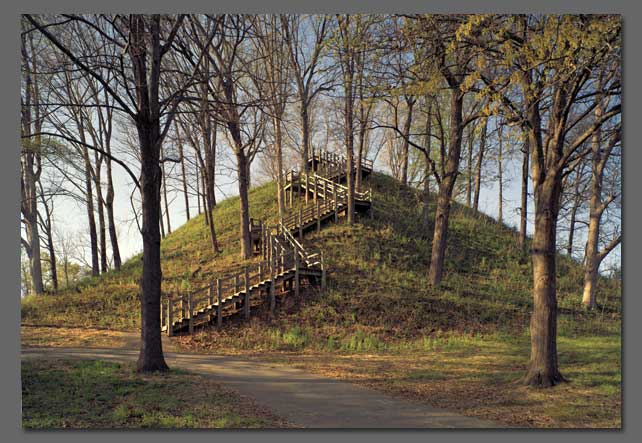The largest Middle Woodland Period (200 bce - 400 ce) archaeological site in the Southeast. Twelve mounds, a geometric earthen enclosure, and ritual activity areas cover four hundred acres. Five large rectangular platform mounds (ranging in height from 7 to 72 feet) of Middle Woodland age underscores the unique nature of the Pinson Mounds site.
A tornado hit Lawrence county yesterday morning, passing about ten miles south of our house. With cloud tops above 45,000 feet high winds approaching from the southwest destroyed four homes and damaged at least 100 more. Five people were injured but fortunately, nobody was killed. That makes 16 tornadoes touching down in our county in the past 18 years (1990-2008).
Memucan Hunt Howard, (1807-1856) expressed a familiar assumption about the lack of indigenous settlements in this part of the country. "I have heard it said that the Indians, when asked why none of them lived in West Tennessee, replied that it leaked too much. For a time, after I first went there I thought it rained, hailed, thundered and lightened with more wind than I had known elsewhere."
At 14 years old, Howard was working as a surveyor in the woods of western Tennessee when his crew came across evidence of 'the one's who came before'. Howard describes the scene of the discovery. "Each party had a trumpet or horn by which we could generally find each other and the packmen, the more readily - The Trumpets were carried at our backs to prevent it from interfering with the with the compass needle. On emerging from the swamp of the middle fork of the Forked Deer River, about a dozen miles above Jackson when going south-to high land we came to a large bold spring of water and camped between it & a mound some six or seven feet high, and extensive enough for Houses & a small yard, and a large body of beautiful rich level heavy timbered land adjacent to it, with which Pinson was so much pleased that some one of the Company proposed to call it Mount Pinson; we did not see or know of the large Mounds two or three miles further South for months afterward, (...) I saw the large mound a year or two later supposed it to be about 70 or 75 feet high, and was nearly four hundred yards in circumference-near it was a square Mound (I think it was square) about twenty feet high smaller Mounds dikes etc. abounded thereabouts."
These earthworks are some of the oldest evidence of human communities in North America. The park where they are located is often empty and silent, a good support for walking meditation best visited between autumn and early spring while the forms of the hills are revealed and the bugs are dormant. Like the monolith in 2001, the mounds present an existential gravitas that plunges the mind into a deeper consideration of our evolutionary origins and cultural patterns. Sir Arthur C. Clarke who passed away last winter gave the monolith the same ratios as the UN Building on the East River in Manhattan. On the most basic level, such consecrated mass evokes a sense of the inherent order of the universe including the ability and obligation to come together and conduct this energy in a pure way. The ultimate artifact has been communicated in various ways throughout history, but beyond all drama and formal expression lies the primary mandala of contelligence, the truth of interdependence. Earthen altars invite participation in the great process of cosmic alchemy, bringing together elements both sentient and non-sentient, bridging past and future, spontaneously harmonizing the aggregates, as loving friends, couples, families, communities, and natural systems in expressing what is already whole by nature.
Built up by manual labor, one basketful of dirt at a time, the mounds contain burials and like major complexes in Mexico and Guatemala, reflect an awareness of astronomical patterns framing yearly agricultural and ritual events. Pyramids, medieval cathedrals, stupas and sun temples the mounds embody subtle signatures of the essential, unchanging reality of radiant being at the heart of all change, an invocation of the sacred nature of space and time, the non-duality of life and death, bridging the world above with the one below.
Tikal, Guatemala
Pinson Mound, TN



No comments:
Post a Comment